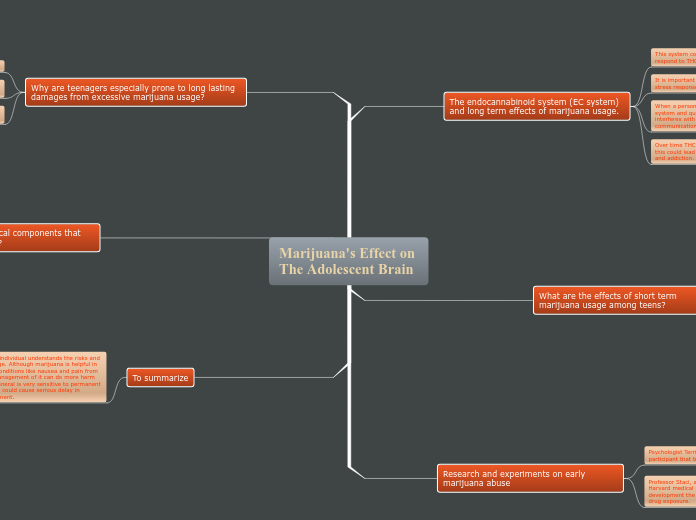Marijuana's Effect on The Adolescent Brain
The endocannabinoid system (EC system) and long term effects of marijuana usage.
This system consists of the physiological mechanisms that respond to THC.
It is important for neurodevelopment, emotional control and stress response.
When a person smokes marijuana, THC overwhelms the EC system and quickly attaches to the cannabinoid receptors. This interferes with the cannabinoid's natural ability of fine tuning communications between the brain and the body.
Over time THC interferes with how the EC system works and this could lead to serious problems like severe memory loss and addiction.
What are the effects of short term marijuana usage among teens?
Impaired senses, difficulty learning and focusing.
Decrease in self confidence and an increased rate of a variety of mental health issues like anxiety and depression.
Less information gets stored up in the brain with heavy cannabis usage. This explains why teenagers that abuse marijuana have a hard time recalling information.
Teenager's begin to prioritize it over activities that they used to enjoy, like playing sports and hanging out with friends.
Research and experiments on early marijuana abuse
Psychologist Terrie Mofit conducted an experiment on 1000 participant that tracked them from ages 13-38.
He found that popular users had a decrease in their IQ of up to 6 points.
Professor Staci, a neuroscientist at McLean hospital and Harvard medical school, says that during this period of brain development the brain is extremely sensitive to damage from drug exposure.
The brain of an adolescent is still neurodevelopmentally immature to outside cannabinoids that interact with our own endocannabinoid system that is still developing in the brain. Marijuana abuse can alter the development trajectory of the brain.
Why are teenagers especially prone to long lasting damages from excessive marijuana usage?
The human brain doesn't fully develop till the age of 25.
Additionally, the frontal cortex, the area responsible for planning, personality and intellect is the last to develop.
Overall, individuals who use marijuana look different from those who don’t in very specific cognitive domains.
What are the chemical components that make up marijuana?
Marijuana is a complex plant with major components like tetrahydrocannabinol (THC) and cannabidiol (CBD) which have opposing effects.
What differentiates the two compounds is the arrangement of a single atom. However, although the difference is only microscopic, THC is a completely different compound then CBD.
THC is responsible for the signature high caused by marijuana.
CBD on the other hand neutralizes the psychoactive effects caused by THC.
The discovery of its compounds has lead to the better understanding of an important neurotransmitter system called the endocannabinoid system
To summarize
It is important that every individual understands the risks and benefits of marijuana usage. Although marijuana is helpful in treating various medical conditions like nausea and pain from cancer therapy, the mismanagement of it can do more harm then good. The brain in general is very sensitive to permanent damage. Early drug abuse could cause serious delay in children's mental development.
